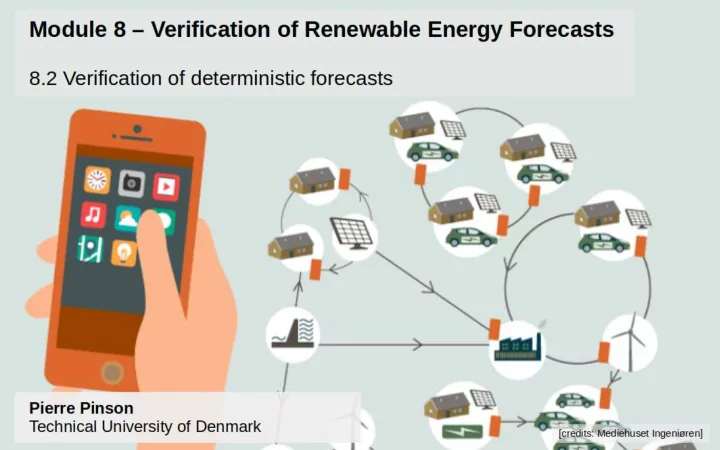

Visual inspection of forecasts Visual inspection allows you to develop susbtantial insight on forecast quality... This comprises a qualitative analysis only What do you think of these two? Are they good or bad? Forecast issued on 16 November 2001 (18:00) Forecast issued on 23 December 2003 (12:00) 2/12
Various types of forecast error patterns Errors in renewable energy generation (but also load, price, etc.) are most often driven by weather forecasts errors Typical error patterns are: amplitude errors (left, below) phase errors (right, below) Forecast issued on 29 March 2003 (12:00) Forecast issued on 6 November 2002 (00:00) 3/12
Quantitative analysis and the forecast error For continuous variables such as renewable energy generation (but also electricity prices or electric load for instance) qualitative analysis ought to be complemented by a quantitative analysis these are based on scores and diagnostic tools The base concept is that of the forecast error : ε t + k | t = y t + k − ˆ y t + k | t , − P n ≤ ε t + k | t ≤ P n where y t + k | t is the forecast issued at time t for time t + k ˆ y t + k is the observation at time t + k P n is the nominal capacity of the wind farm It can be calculated directly for the quantity of interest as a normalized version, for instance by dividing by the nominal capacity of the wind farm if evaluating wind power forecasts: ε t + k | t = y t + k − ˆ y t + k | t − 1 ≤ ε t + k | t ≤ 1 , P n 4/12
Forecast error: examples Example 1: If the 24-ahead prediction for Klim is of 18 MW, while the observation is 15.5MW ε t + k | t = − 2 . 5MW (if not normalized) ε t + k | t = − 0 . 119 (or, -11.9%, if normalized) Example 2: forecast issued on the 6 November 2002 (00:00) Corresponding forecast errors Forecast and observations (Note that we prefer to work with normalized errors from now on...) 5/12
Scores for point forecast verification One cannot look at all forecasts, observations, and forecasts errors over a long period of time Scores are to be used to summarize aspects of forecast accuracy... The most common scores include, as function of the lead time k : bias (or Nbias, for the normalized version) bias( k ) = 1 � T t =1 ε t + k | t T Mean Absolute Error (MAE) (or NMAE, for the normalized version) MAE( k ) = 1 � T t =1 | ε t + k | t | T Root Mean Square Error (RMSE) (or NRMSE, for the normalized version) � 1 � 1 2 � T t =1 ε 2 RMSE( k ) = t + k | t T MAE and RMSE are negatively-oriented (the lower, the better) Let us discuss their advantages and drawbacks... 6/12
Example: calculating a few scores at Klim Period: 1.7.2012 - 31.12.2012 Forecats quality necessarily degrades with further lead times For instance, for 24-ahead forecasts: bias is close to 0, while NMAE and NRMSE are of 8% and 12%, respectively on average, there is ± 1.68 MW between forecasts and measurements 7/12
Comparing against benchmark approaches Forecasts from advanced methods are expected to outperform simple benchmarks! Two typical benchmarks are (to be further discussed in a further Module): Persistence (“what you see is what you get”): ˆ y t + k | t = y t , k = 1 , 2 , . . . Climatology (the “once and for all” strategy): ˆ y t + k | t = ¯ y t , k = 1 , 2 , . . . where ¯ y t is the average of all measurements available up to time t A skill score informs of the relative quality of a method vs. a relevant benchmark, for a given lead time k : SSc( k ) = 1 − Sc adv ( k ) SSc ≤ 1 (possibly expressed in %) Sc ref ( k ) , where ’Sc’ can be MAE, RMSE, etc., ’Sc adv ’ is score value for the advanced method, and ’Sc ref ’ is for the benchmark 8/12
Example: benchmarking at Klim Great! My forecasts are way better than the benchmarks considered (in terms of RMSE) Additional comments: persistence is difficult to outperform for short lead times climatology is difficult to outperform for longer lead times 9/12
Diagnostic tools based on error distributions Scores are summary statistics They only give a partial view of forecast quality A full analysis of error distributions may tell you so much more! 5 5 4 4 3 3 frequency frequency 2 2 1 1 0 0 −1.0 −0.5 0.0 0.5 1.0 −1.0 −0.5 0.0 0.5 1.0 normalized forecast error normalized forecast error 24-ahead forecasts 36-ahead forecasts 1 July 2002 - 31 December 2002 1 July 2002 - 31 December 2002 10/12
Analysis of “extreme” errors For risk management reason, you may be interested in knowing more about extreme forecast errors For the test case of Klim and the same period: The upper plot informs of the value X (in % of P n ) for which 95% of prediction errors are less than X The lower plot tells about the percentage of prediction errors being greater than 0.2 P n (20% of the nominal capacity) 11/12
Recommend
More recommend